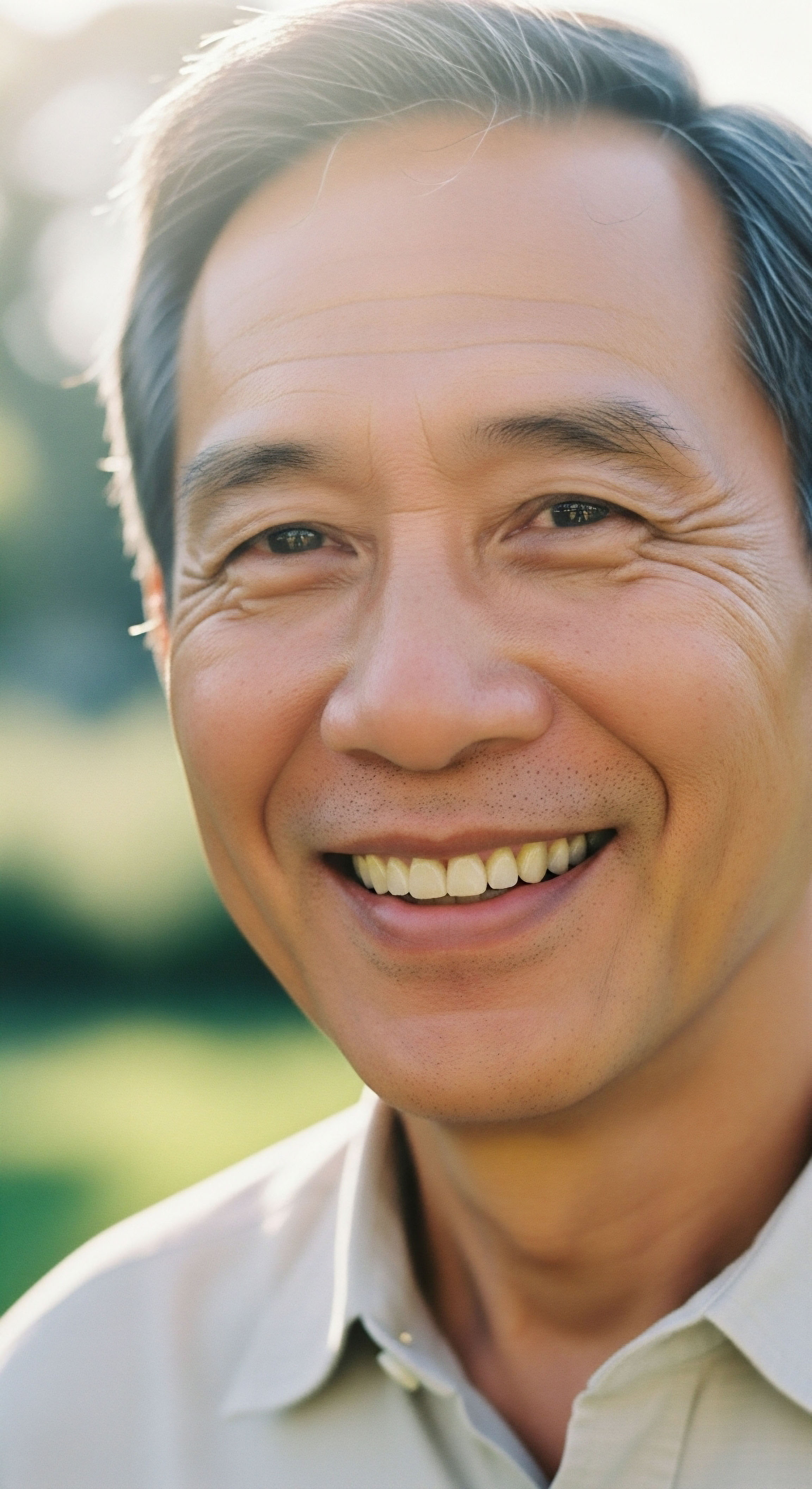

Fundamentals
The exhaustion you feel is not just in your head; it is a physiological reality written into the very architecture of your sleep. Many men describe a profound sense of running on empty, where a full night’s rest feels increasingly out of reach.
This experience of waking up feeling unrestored, as if the restorative processes of sleep failed to engage, is a valid and common starting point for investigating hormonal health. Your body’s internal clockwork is deeply connected to its hormonal state, and when one is disrupted, the other often follows. Understanding this connection is the first step toward addressing the root cause of this pervasive fatigue.
Sleep is constructed in cycles, moving through different stages of non-rapid eye movement (NREM) and rapid eye movement (REM) sleep. Think of these stages as a team of specialists, each with a unique role. The lighter stages of NREM initiate the process, but the deep, slow-wave sleep Meaning ∞ Slow-Wave Sleep, also known as N3 or deep sleep, is the most restorative stage of non-rapid eye movement sleep. (SWS) stage is where the most significant physical restoration occurs.
During SWS, your body repairs tissues, builds bone and muscle, and strengthens the immune system. REM sleep, in contrast, is essential for cognitive functions, including memory consolidation and emotional regulation. A healthy night of sleep depends on cycling smoothly through these stages multiple times.
The quality of your sleep is directly tied to the predictable, cyclical release of key hormones, with testosterone being a primary driver of this nocturnal process.

The Endocrine Conductor of Nightly Renewal
Testosterone production is intrinsically linked to this sleep architecture. The majority of daily testosterone release in men occurs during sleep, synchronized with these cycles. Specifically, the onset of slow-wave sleep triggers a significant surge in luteinizing hormone (LH) from the pituitary gland, which in turn signals the testes to produce testosterone.
This peak is not governed by the time of day but by the achievement of deep sleep itself. Consequently, anything that fragments sleep and prevents you from entering or remaining in SWS ∞ be it stress, noise, or an underlying sleep disorder ∞ directly curtails this vital hormonal production. The result is a vicious cycle ∞ poor sleep leads to lower testosterone, and lower testosterone levels Meaning ∞ Testosterone levels denote the quantifiable concentration of the primary male sex hormone, testosterone, within an individual’s bloodstream. are associated with poorer sleep quality, particularly a reduction in the restorative SWS stage.
This biological loop explains why men with low testosterone Meaning ∞ Low Testosterone, clinically termed hypogonadism, signifies insufficient production of testosterone. often report symptoms of chronic fatigue, cognitive fog, and a lack of vitality that persists despite getting a seemingly adequate number of hours in bed. The issue lies in the quality and structure of that sleep.
Without sufficient SWS, the body misses its primary window for both physical repair and hormonal synthesis. The feeling of being unrestored is a direct reflection of a system that has been deprived of its most critical regenerative phase.

What Is the Consequence of Sleep Fragmentation?
When sleep is repeatedly interrupted, you may cycle through the lighter stages of sleep without ever reaching the deeper, more restorative ones. This fragmentation has profound consequences for the Hypothalamic-Pituitary-Gonadal (HPG) axis, the sophisticated feedback loop that governs testosterone production. Each awakening, however brief, can reset the process, blunting the nocturnal testosterone surge. Over time, this chronic disruption can lead to clinically low testosterone levels, a condition known as hypogonadism. The symptoms extend beyond simple tiredness, often including:
- Reduced Libido ∞ A direct consequence of insufficient testosterone.
- Mood Disturbances ∞ Increased irritability and a lower stress threshold are common.
- Decreased Muscle Mass ∞ The body’s ability to repair and build muscle tissue overnight is impaired.
- Increased Body Fat ∞ Hormonal imbalances can shift metabolism towards fat storage, particularly around the abdomen.
Recognizing that your sleep quality Meaning ∞ Sleep quality refers to the restorative efficacy of an individual’s sleep, characterized by its continuity, sufficient depth across sleep stages, and the absence of disruptive awakenings or physiological disturbances. and hormonal health are two sides of the same coin is a foundational insight. It shifts the focus from merely “getting more sleep” to restoring the biological integrity of your sleep architecture. This perspective empowers you to ask more precise questions about your health and seek solutions that address the underlying system, not just the symptoms.


Intermediate
When foundational efforts to improve sleep hygiene fail to resolve the persistent fatigue and other symptoms of low testosterone, a more direct intervention may be necessary. Testosterone replacement therapy Meaning ∞ Testosterone Replacement Therapy (TRT) is a medical treatment for individuals with clinical hypogonadism. (TRT) is a clinical protocol designed to restore this crucial hormone to a healthy physiological range.
The objective of this biochemical recalibration is to re-establish the body’s signaling environment, allowing for the normalization of numerous processes, including the regulation of sleep architecture. By replenishing testosterone, the therapy aims to break the cycle of poor sleep and low hormonal output, thereby improving sleep quality Improving sleep alone optimizes hormonal function, yet significant imbalances often require targeted clinical protocols for full restoration. and daytime function.
The administration of testosterone can be accomplished through various methods, each with its own pharmacokinetic profile. Weekly intramuscular or subcutaneous injections of Testosterone Cypionate are a common and effective protocol. This method provides a predictable peak in testosterone levels, which then gradually tapers over the week.
Other options include transdermal gels, which offer more stable daily levels, and long-acting pellets implanted under the skin. The choice of delivery system is a clinical decision based on a patient’s lifestyle, metabolic factors, and treatment goals. The aim is to mimic the body’s natural rhythm as closely as possible, although no exogenous method can perfectly replicate the natural pulsatility of endogenous production.

The Critical Link between TRT and Obstructive Sleep Apnea
A significant consideration in testosterone therapy Meaning ∞ A medical intervention involves the exogenous administration of testosterone to individuals diagnosed with clinically significant testosterone deficiency, also known as hypogonadism. is its relationship with Obstructive Sleep Apnea (OSA). OSA is a condition where the upper airway repeatedly collapses during sleep, leading to pauses in breathing (apneas) and shallow breaths (hypopneas). These events cause blood oxygen levels to drop and trigger brief arousals from sleep, severely fragmenting sleep architecture and preventing access to SWS and REM stages.
Obesity is a primary risk factor for OSA, and it is also independently associated with low testosterone, creating a complex clinical picture.
Testosterone therapy does not cause OSA, but it can unmask or worsen an existing, undiagnosed condition. The mechanisms are thought to be centrally mediated rather than structural. Testosterone may increase the collapsibility of the upper airway muscles and alter the chemosensitivity of the brain’s respiratory control centers.
For this reason, responsible clinical practice includes screening for OSA before initiating TRT, especially in men with risk factors like obesity, a large neck circumference, or heavy snoring. If OSA is suspected, a sleep study (polysomnography) is the definitive diagnostic tool.
Effective hormonal optimization requires a systems-based approach, where sleep health and respiratory function are considered integral components of the treatment plan.
If a patient is diagnosed with OSA, it must be managed concurrently with TRT. The gold standard treatment for moderate to severe OSA is Continuous Positive Airway Pressure Continuous temperature control in pharmaceutical transit mirrors the body’s precise hormonal regulation, ensuring biological integrity and optimal function. (CPAP), a device that delivers pressurized air to keep the airway open during sleep.
By preventing apneas and arousals, CPAP restores sleep architecture, which can itself have a positive effect on natural testosterone production. When TRT and CPAP are used together, the benefits of hormonal optimization Meaning ∞ Hormonal Optimization is a clinical strategy for achieving physiological balance and optimal function within an individual’s endocrine system, extending beyond mere reference range normalcy. can be realized without the risk of exacerbating sleep-disordered breathing.

Optimizing Protocols for Sleep and Safety
A well-designed TRT protocol goes beyond simply administering testosterone. It involves a comprehensive approach to managing the entire endocrine system. For men, this often includes ancillary medications to ensure the system remains balanced.
The following table outlines key components of a modern TRT protocol and their relevance to sleep and overall health:
| Component | Purpose | Relevance to Sleep Architecture |
|---|---|---|
| Testosterone Cypionate | The primary androgen used to restore testosterone levels to a healthy physiological range. | Directly supports the hormonal cascade that promotes slow-wave sleep. Restoring levels can improve sleep efficiency and reduce nocturnal awakenings. |
| Gonadorelin (or hCG) | A peptide that mimics Gonadotropin-Releasing Hormone (GnRH), stimulating the pituitary to produce LH and FSH. This maintains testicular function and some endogenous testosterone production. | Helps maintain the natural pulsatility of the HPG axis, which is closely tied to sleep-wake cycles. It prevents complete testicular shutdown, supporting a more balanced endocrine state. |
| Anastrozole | An aromatase inhibitor that blocks the conversion of testosterone to estradiol (estrogen). Used to manage estrogen levels and prevent side effects like water retention. | Estradiol has complex effects on sleep. Excessively high levels can disrupt sleep architecture. Maintaining an optimal testosterone-to-estradiol ratio is key for sleep quality. |
| CPAP Therapy | Continuous Positive Airway Pressure, used to treat diagnosed Obstructive Sleep Apnea. | Essential for patients with OSA. By preventing airway collapse and hypoxia, CPAP allows for consolidated sleep, enabling the patient to reach SWS and REM stages, which unlocks the full benefits of TRT. |
For women experiencing sleep disturbances related to perimenopause or post-menopause, hormonal optimization takes a different form. It may involve low-dose testosterone therapy, often combined with progesterone, which has its own sleep-promoting properties. The goal remains the same ∞ to restore balance to a system in flux, thereby improving sleep quality and overall well-being.


Academic
The influence of testosterone therapy on sleep architecture Meaning ∞ Sleep architecture denotes the cyclical pattern and sequential organization of sleep stages: Non-Rapid Eye Movement (NREM) sleep (stages N1, N2, N3) and Rapid Eye Movement (REM) sleep. is a nuanced process governed by its metabolic conversion into two potent signaling molecules ∞ dihydrotestosterone (DHT) and 17β-estradiol (E2). While testosterone itself has direct androgenic effects, its impact on the central nervous system’s sleep-wake regulatory centers is largely mediated by these metabolites.
The enzymes responsible for this conversion ∞ 5α-reductase (for DHT) and aromatase (for E2) ∞ are present in key brain regions, including the hypothalamus and brainstem. This localized conversion allows for a highly specific modulation of neural circuits that control the transitions between wakefulness, NREM sleep, and REM sleep.
Understanding the distinct roles of these three hormones provides a more complete picture of how TRT recalibrates sleep. Testosterone, DHT, and estradiol Meaning ∞ Estradiol, designated E2, stands as the primary and most potent estrogenic steroid hormone. do not function interchangeably; they bind to different receptor populations and trigger unique downstream signaling cascades. The net effect of testosterone therapy on an individual’s sleep is therefore a composite of the actions of these three distinct hormonal messengers on a complex neural network.

The Three Messengers and Their Neuromodulatory Roles
The brain’s sleep-promoting and wake-promoting centers are populated with androgen receptors (AR) and estrogen receptors (ER-α and ER-β). The differential effects of testosterone and its metabolites arise from their binding affinities and the specific receptor types they activate.
- Testosterone (T) ∞ As the precursor hormone, testosterone serves as the primary substrate for local conversion in the brain. While it can bind directly to androgen receptors, its most profound effects on sleep appear to be mediated through its metabolites. Its systemic administration creates the necessary hormonal gradient to drive these localized conversion processes within the CNS.
- Dihydrotestosterone (DHT) ∞ This is a potent, non-aromatizable androgen, meaning it cannot be converted into estrogen. It binds with high affinity to androgen receptors. Its role in sleep is complex; some evidence suggests it may have a lesser role in sleep modulation compared to estradiol, but its potent androgenic effects on other systems can indirectly influence sleep. For instance, its role in maintaining muscle mass and metabolic rate contributes to overall physiological stability.
- Estradiol (E2) ∞ Produced from testosterone via the aromatase enzyme, estradiol is a powerful neuromodulator with significant influence over sleep architecture. In men, brain-derived estradiol is critical. Studies in animal models have shown that estradiol can suppress REM sleep and promote wakefulness, particularly during the active phase. This suggests that the balance between androgenic and estrogenic signaling is a critical determinant of sleep structure. An improper T/E2 ratio, often seen in unmanaged TRT, can lead to sleep fragmentation.
The brain acts as a local endocrine organ, converting circulating testosterone into specific metabolites to fine-tune the activity of sleep-regulating neural circuits.

How Does TRT Interact with Sleep Regulatory Circuits?
The primary sleep switch is located in the preoptic area of the hypothalamus, containing sleep-active GABAergic neurons. The wakefulness-promoting systems include monoaminergic neurons in the brainstem and cholinergic neurons in the basal forebrain. Testosterone, DHT, and estradiol modulate the activity of these competing circuits.
For example, estradiol has been shown to influence the activity of the ventrolateral preoptic nucleus (VLPO), a key sleep-promoting region. By modulating these neurons, brain-derived estradiol can influence the timing and duration of sleep stages. The well-documented risk of TRT worsening OSA also has a neurochemical basis.
Androgens are known to affect the function of the hypoglossal nerve, which controls the tongue muscles critical for maintaining airway patency. Altered signaling could reduce muscle tone during sleep, increasing the likelihood of airway collapse.
The following table summarizes findings from various studies, illustrating the complex and sometimes divergent effects of sex steroids on sleep parameters. This highlights the importance of personalized, well-monitored therapy.
| Hormonal State / Intervention | Observed Effect on Sleep Architecture | Primary Mediator(s) | Reference Context |
|---|---|---|---|
| Low Endogenous Testosterone | Reduced sleep efficiency, increased awakenings, decreased slow-wave sleep (SWS). | Testosterone, Estradiol | Observed in older men and men with hypogonadism. |
| Physiological TRT (Managed) | Improved sleep efficiency, potential increase in SWS, subjective improvement in sleep quality. | Testosterone, Estradiol | Clinical goal in hypogonadal men without untreated OSA. |
| High-Dose/Supraphysiological TRT | Reduced total sleep time, decreased sleep efficiency, potential worsening of OSA. | Testosterone, Estradiol | Associated with anabolic steroid use or poorly managed TRT. |
| Androgen Blockade | No significant effect on sleep architecture or breathing in men with existing OSA. | Testosterone, DHT | Suggests that simply blocking androgens may not reverse established OSA pathology. |
| Aromatase Inhibition (Anastrozole) | Prevents conversion of T to E2, used to manage estradiol levels. | Estradiol | Clinically used to optimize the T/E2 ratio, which can mitigate estrogen-related sleep disruption. |
This evidence underscores that hormonal optimization is a delicate balancing act. The goal of TRT is not simply to elevate a number on a lab report, but to restore a complex signaling system. The impact on sleep architecture is a direct outcome of how successfully this therapy recreates a physiological balance between testosterone and its powerful metabolites within the central nervous system.

References
- Wittert, G. “The relationship between sleep disorders and testosterone in men.” Journal of Clinical Endocrinology & Metabolism, vol. 99, no. 5, 2014, pp. 1654-60.
- Luboshitzky, R. et al. “The effect of testosterone administration on sleep and sleep-disordered breathing in men with obstructive sleep apnea.” American Journal of Respiratory and Critical Care Medicine, vol. 157, no. 1, 1998, pp. 121-27.
- Barrett-Connor, E. et al. “The association of testosterone levels with overall sleep quality, sleep architecture, and sleep-disordered breathing.” The Journal of Clinical Endocrinology & Metabolism, vol. 93, no. 7, 2008, pp. 2602-09.
- Meston, C. M. & Frohlich, P. F. “The neurobiology of sexual function.” Archives of General Psychiatry, vol. 57, no. 11, 2000, pp. 1012-30.
- Mong, J. A. & Cusmano, D. M. “Sex differences in sleep ∞ impact of biological sex and sex steroids.” Philosophical Transactions of the Royal Society B ∞ Biological Sciences, vol. 371, no. 1688, 2016, p. 20150110.
- Liu, Y. et al. “Short-term, high-dose testosterone treatment shortens sleep and worsens sleep-disordered breathing in men.” Sleep, vol. 25, no. 1, 2002, pp. 33-37.
- Hoyos, C. M. et al. “Effects of testosterone therapy on sleep and breathing in obese men with severe obstructive sleep apnoea ∞ a randomized controlled trial.” Clinical Endocrinology, vol. 77, no. 4, 2012, pp. 599-607.
- Shin, J. J. & Kacker, A. “Obstructive sleep apnea and testosterone deficiency.” Urology, vol. 70, no. 6, 2007, pp. 1033-37.
- Deurveilher, S. et al. “Estradiol and progesterone modulate spontaneous sleep patterns and recovery from sleep deprivation in ovariectomized rats.” Sleep, vol. 32, no. 7, 2009, pp. 863-75.
- Giannotti, F. & Cortesi, F. “Sleep and hormones.” Neuroendocrinology Letters, vol. 23, suppl. 1, 2002, pp. 53-60.

Reflection

Charting Your Own Biological Course
The information presented here provides a map of the intricate biological landscape connecting your hormonal state to the quality of your nightly rest. This knowledge serves as a powerful tool, moving you from a position of experiencing symptoms to one of understanding systems. The journey toward reclaimed vitality begins with this internal shift in perspective.
Your lived experience of fatigue or unrefreshing sleep is not a subjective complaint but a valuable piece of data, pointing toward specific physiological processes that can be investigated and understood.
Consider the patterns of your own energy and rest. Think about the times you have felt fully restored versus the times you have felt depleted. This personal data, when viewed through the lens of endocrine and sleep science, becomes the starting point for a more productive conversation about your health.
The ultimate goal is to achieve a state of function and well-being that is not compromised by correctable biological imbalances. Armed with this deeper understanding, you are better equipped to partner with a clinical expert to navigate your unique path toward that goal.












